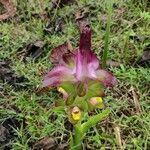A large ginger family herb. It can be 2 m high. The rhizome is large. The rhizome and tuberous roots are yellow. It forms many tillers or runners. It has robust false stems. It has sheaths near the base. The leaves are alternate and narrowly oval. They are wedge shaped at the base and extend along the leaf stalk. They are 25-100 cm long by 8-20 cm wide. The flowering shoot grows from the rhizome or underground stem beside the leaf stalk. The stalk is 10-25 cm long and 1-2 cm thick. The flowers are short and broad and they develop in a sequence along the stalk.

